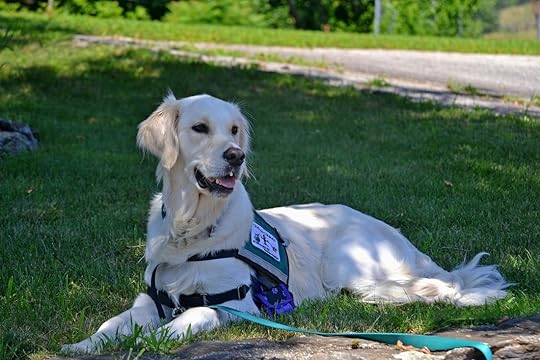How Different Types of Service Dogs Can Improve someone's Daily Life
 Animals are heroes; they impact people’s lives. Last week the Hero Dog Awards were presented by the American Humane Association and broadcast on the Hallmark Channel. These seven dogs all impact people, whether through their law enforcement or military service, bringing smiles to people in hospitals and nursing homes, or simply through their tenacious spirit after a time of abuse – dogs inspire us, if we let them.
Animals are heroes; they impact people’s lives. Last week the Hero Dog Awards were presented by the American Humane Association and broadcast on the Hallmark Channel. These seven dogs all impact people, whether through their law enforcement or military service, bringing smiles to people in hospitals and nursing homes, or simply through their tenacious spirit after a time of abuse – dogs inspire us, if we let them.I recently wrote post about Animal Heroes. This week, I’m pleased to present a guest blogger who will showcase some types of hero dogs, particularly service dogs who help people with various afflictions. For years, I’ve admired organizations who help people in need of service dogs, groups like Canine Companions for Independence, located in Santa Rosa, California, a community devastated by recent wildfires (thankfully, CCI’s facilities and dogs survived that inferno). I hope you enjoy Paige’s article regarding service dogs and the assistance they provide people – these types of dogs are truly heroes!
**********************************************************************************
Guest Post by Paige Johnson
There are vast types of service dogs, including severe allergy alert dogs, autism assistance dogs, mobility support dogs, diabetic alert dogs, medical assistance dogs, emotional support dogs, psychiatric service dogs, and more. These distinctions can be broken down into three major categories: mental illnesses, permanent mental disabilities, and physical conditions that require assistance. The Great Danes from Service Dog Project, Inc., for example, are for mobility. You would be amazed by what this can do for someone who might become stuck behind a 6-inch curb.
This article will touch on each of the above-mentioned major categories, and how having a service dog can significantly improve day-to-day life for people with such conditions.
Physical Conditions
Perhaps the most complex of the three categories are service dogs that aid physical conditions such as mobility support, allergy alert, medical assistance, and seizure response. These dogs require a substantial amount of training, as outlined by Paws Training Centers. It can take years to fully prepare a dog for the complexities of physical support. Each situation is different. For this reason, training regimens vary greatly.
Common skills include the ability to notice people approaching, to respond to a name, recognize specific sounds or smells (such as detecting low blood sugar levels), seek help from others, press a medical button, wake up an owner or retrieve personal items. Physical support dogs should be able to apply pressure, cuddle on cue, respond to anxiety or panic attacks, and interrupt nightmares or night terrors caused by PTSD (Post Traumatic Stress Disorder). As you can probably tell, physical support dogs accept a great deal of responsibility for the health and well-being of their owners. They are, quite literally, life-saving animals. Therefore, when you notice a support dog in public, you should never approach without asking first. These dogs are trained to detect danger and could perceive you as a threat, and they are working, caring for their special person. Physical support dogs are far from pets. They are considered companions and dogs with a job.
Mental Illnesses
People with issues such as panic disorder, general anxiety disorder, and depression are aided by emotional support dogs. These dogs require little or no training. They can live in all rented spaces, much like other support dogs. However, they are not always allowed in public places. This is because any pet can be considered an emotional support animal. You can register guinea pigs, cats, dogs, rabbits, or ferrets. If you feel comforted in the presence of your pet, you can register him or her as a support animal. Most non-pet apartment complexes will ask for a record of your counseling or mental diagnosis to ensure that you aren’t taking advantage of the system.
If you choose to get a service dog for your mental illness, understand the difference between a physical and emotional support dog. Should you decide to bring your dog to public spaces as though he or she is a physical support animal, it is your responsibility to provide training. Learn more about access and legal issues through Nolo.
It’s also worth noting that many people who are in recovery from substance abuse addiction find that companion animals are great options for support when managing sobriety and navigating through the difficult aspects of recovery. Animals used in this aspect, while offering emotional support, are not eligible for registration as a support animal, but they still provide ample comfort at home.
Not sure if you need an emotional support dog for your anxiety or mental illness? Anxiety Guru can help you make an informed decision.
Permanent Mental Disabilities
Our final category involves permanent mental disabilities such as autism. Called Autism Support Dogs, these animals are somewhere between physical and emotional service dogs. They do, in fact, require training. They are also respected in public areas as a physical support dog. Their job is to calm and ground an individual through deep pressure or tactile stimulation. They may also help teach important life skills. There is special bond between children and dogs, and those youngsters (as well as teens and adults) paired with such service dogs can see improvements in their lives and therefore, also in their loved ones.
All three categories of service dogs can improve your daily life by making you smile, helping you accomplish otherwise impossible physical feats, or comforting you when you need it most. Remember though there are laws against “faking” a service dog, and those people who really need a service animal can be affected by others who decide to try to by-pass the rules about housing or traveling with a dog. True service dogs are vital companions and often life-saving ones for people with various mental and physical issues.
Whether in need of a service dog or not, consider adopting from breed-specific rescues or animal welfare shelters and getting involved in the Canine Good Citizen Program, which is considered the “gold standard” for dog behavior.
Author Bio
Paige Johnson is a fitness nerd and animal lover. She shares her insights on LearnFit. She loves offering advice on a variety of topics. As a personal trainer, she has a passion for fitness training and enjoys sharing her knowledge with those seeking to live a healthier lifestyle. She's also mom to three dogs, all rescues, and volunteers at her local animal shelter. Through her time with her own pups and working at the shelter, she's picked up some great tips on pet care and training.
Photos from Pixabay.com

Published on November 01, 2017 05:00
No comments have been added yet.



